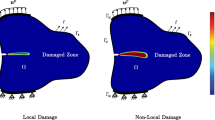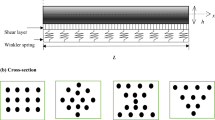Abstract
This paper proposes an efficient methodology for concurrent multi-scale design optimization of composite frames considering specific design constraints to obtain the minimum structure cost when the fundamental frequency is considered as a constraint. To overcome the challenge posed by the strongly singular optimum and the weakness of the conventional polynomial material interpolation (PLMP) scheme, a new area/moment of inertia–density interpolation scheme, which is labeled as adapted PLMP (APLMP) is proposed. The APLMP scheme and discrete material optimization approach are employed to optimize the macroscopic topology of a frame structure and microscopic composite material selection concurrently. The corresponding optimization formulation and solution procedures are also developed and validated through numerical examples. Numerical examples show that the proposed APLMP scheme can effectively solve the singular optimum problem in the multi-scale design optimization of composite frames with fundamental frequency constraints. The proposed multi-scale optimization model for obtaining the minimum cost of structures with a fundamental frequency constraint is expected to provide a new choice for the design of composite frames in engineering applications.




















Similar content being viewed by others
References
Andreasen CS, Sigmund O (2012) Multiscale modeling and topology optimization of poroelastic actuators. Smart Mater Struct 21(6):065005
Bailie JA, Ley RP, Pasricha A (1997) A summary and review of composite laminate design guidelines. National Aeronautics and Space Administration, Final Report Task 22
Bendsoe MP, Sigmund O (2013) Topology optimization-theory, methods and applications. Springer Science & Business Media, New York
Bruggi M (2008) On an alternative approach to stress constraints relaxation in topology optimization. Struct Multidiscip Optim 36(2):125–141
Bruyneel M (2011) SFP-a new parameterization based on shape functions for optimal material selection: application to conventional composite plies. Struct Multidiscip Optim 43(1):17–27
Cheng GD, Guo X (1997) ε-relaxed approach in structural topology optimization. Struct Optim 13(4):258–266
Cheng GD, Olhoff N (1993) Rigid body motion test against error in semi-analytical sensitivity analysis. Comput Struct 46(3):515–527
Coelho PG, Fernandes PR, Guedes JM, Rodrigues HC (2008) A hierarchical model for concurrent material and topology optimisation of three-dimensional structures. Struct Multidiscip Optim 35(2):107–115
Coelho PG, Guedes JM, Rodrigues HC (2015) Multiscale topology optimization of bi-material laminated composite structures. Compos Struct 132:495–505
Costa G, Montemurro M, Pailhès J (2018) A 2D topology optimisation algorithm in NURBS framework with geometric constraints. Int J Mech Mater Des 14(4):669–696
Costa G, Montemurro M, Pailhès J (2019a) NURBS hyper-surfaces for 3D topology optimization problems. Mech Adv Mater Struct 28(7):665–684
Costa G, Montemurro M, Pailhès J (2019b) Minimum length scale control in a NURBS-based SIMP method. Comput Methods Appl Mech Eng 354:963–989
Deng JD, Yan J, Cheng GD (2013) Multi-objective concurrent topology optimization of thermoelastic structures composed of homogeneous porous material. Struct Multidiscip Optim 47(4):583–597
Du JB, Olhoff N (2007) Topological design of freely vibrating continuum structures for maximum values of simple and multiple eigenfrequencies and frequency gaps. Struct Multidiscip Optim 34(2):91–110
Duan ZY, Yan J, Zhao GZ (2015) Integrated optimization of the material and structure of composites based on the Heaviside penalization of discrete material model. Struct Multidiscip Optim 51(3):721–732
Duan ZY, Yan J, Lee IJ, Lund E, Wang JY (2019a) A two-step optimization scheme based on equivalent stiffness parameters for forcing convexity of fiber winding angle in composite frames. Struct Multidiscip Optim 59(6):2111–2129
Duan ZY, Yan J, Lee IJ, Lund E, Wang JY (2019b) Discrete material selection and structural topology optimization of composite frames for maximum fundamental frequency with manufacturing constraints. Struct Multidiscip Optim 60(5):1741–1758
Ferreira RT, Rodrigues HC, Guedes JM, Hernandes JA (2013) Hierarchical optimization of laminated fiber reinforced composites. Compos Struct 107:246–259
Guo X, Cheng GD (2000) An extrapolation approach for the solution of singular optima. Struct Multidiscip Optim 19(4):255–262
Gao T, Zhang WH, Duysinx P (2013) Simultaneous design of structural layout and discrete fiber orientation using bi-value coding parameterization and volume constraint. Struct Multidiscip Optim 48(6):1075–1088
Gao J, Luo Z, Li H, Gao L (2019) Topology optimization for multiscale design of porous composites with multi-domain microstructures. Comput Methods Appl Mech Eng 344:451–476
Giulio G, Montemurro M (2020) Eigen-frequencies and harmonic responses in topology optimisation: a CAD-compatible algorithm. Eng Struct 214:110602
Huang X, Zhou SW, Xie YM, Li Q (2013) Topology optimization of microstructures of cellular materials and composites for macrostructures. Comput Mater Sci 67:397–407
Hvejsel CF, Lund E (2011) Material interpolation schemes for unified topology and multi-material optimization. Struct Multidiscip Optim 43(6):811–825
Izzi MI, Montemurro M, Catapano A, Pailhès J (2020) A multi-scale two-level optimisation strategy integrating a global/local modelling approach for composite structures. Compos Struct 237:111908
Jones RM (2014) Mechanics of composite materials. CRC Press, Boca Raton
Liu L, Yan J, Cheng GD (2008) Optimum structure with homogeneous optimum truss-like material. Comput Struct 86(13):1417–1425
Lund E (1994) Finite element based design sensitivity analysis and optimization. Institute of Mechanical Engineering, Aalborg University, Denmark, p 107
Ma XT, Tian K, Li H, Zhou Y, Hao P, Wang B (2020) Concurrent multi-scale optimization of hybrid composite plates and shells for vibration. Compos Struct 233:111635
Montemurro M, Pagani A, Fiordilino GA, Pailhès J, Carrera E (2018) A general multi-scale two-level optimisation strategy for designing composite stiffened panels. Compos Struct 201:968–979
Mallick P.K., Fiber-reinforced composites: materials, manufacturing, and design. CRC press, 2017.
Martins LAL, Bastian FL, Netto TA (2014) Reviewing some design issues for filament wound composite tubes. Mater Des 55:242–249
Ni CH, Yan J, Cheng GD, Guo X (2014) Integrated size and topology optimization of skeletal structures with exact frequency constraints. Struct Multidiscip Optim 50(1):113–128
Nikbakt S, Kamarian S, Shakeri M (2018) A review on optimization of composite structures Part I: laminated composites. Compos Struct 195:158–185
Niu B, Yan J, Cheng GD (2009) Optimum structure with homogeneous optimum cellular material for maximum fundamental frequency. Struct Multidiscip Optim 39(2):115–132
Ohsaki M, Fujisawa K, Katoh N, Kanno Y (1999) Semi-definite programming for topology optimization of trusses under multiple eigenvalue constraints. Comput Methods Appl Mech Eng 180(1–2):203–217
Panettieri E, Montemurro M, Catapano A (2019) Blending constraints for composite laminates in polar parameters space. Compos B Eng 168:448–457
Rodrigues H, Guedes JM, Bendsoe MP (2002) Hierarchical optimization of material and structure. Struct Multidiscip Optim 24(1):1–10
Scardaoni MP, Montemurro M (2020) A general global-local modelling framework for the deterministic optimisation of composite structures. Struct Multidiscip Optim 62:1927–1949
Scardaoni MP, Montemurro M, Panettieri E, Catapano A (2021) New blending constraints and a stack-recovery strategy for the multi-scale design of composite laminates. Struct Multidiscip Optim 63(2):741–766
Sørensen SN, Sørensen R, Lund E (2014) DMTO–a method for discrete material and thickness optimization of laminated composite structures. Struct Multidiscip Optim 50(1):25–47
Stegmann J, Lund E (2005) Discrete material optimization of general composite shell structures. Int J Numer Meth Eng 62(14):2009–2027
Svanberg K (2007) MMA and GCMMA, versions September 2007. Optim Syst Theory 104.
Tao W, Liu Z, Zhu P, Zhu C, Chen W (2017) Multi-scale design of three dimensional woven composite automobile fender using modified particle swarm optimization algorithm. Compos Struct 181:73–83
Wittrick WH (1962) Rates of change of eigenvalues, with reference to buckling and vibration problems. Aeronaut J 66(621):590–591
Wu C, Gao Y, Fang J, Lund E, Li Q (2019) Simultaneous discrete topology optimization of ply orientation and thickness for carbon fiber reinforced plastic-laminated structures. J Mech Des 141(4):044501
Xia L, Breitkopf P (2014) Concurrent topology optimization design of material and structure within FE2 nonlinear multiscale analysis framework. Comput Methods Appl Mech Eng 278:524–542
Xu B, Jiang J, Tong W, Wu K (2003) Topology group concept for truss topology optimization with frequency constraints. J Sound Vib 261(5):911–925
Xu B, Xie YM (2015) Concurrent design of composite macrostructure and cellular microstructure under random excitations. Compos Struct 123:65–77
Xu YJ, Zhu J, Wu Z, Cao Y, Zhao Y, Zhang W (2018) A review on the design of laminated composite structures: constant and variable stiffness design and topology optimization. Adv Compos Hybrid Mater 1(3):460–477
Xuan L, Du JB (2019) Concurrent multi-scale and multi-material topological optimization of vibro-acoustic structures. Comput Methods Appl Mech Eng 349:117–148
Yamada S, Kanno Y (2016) Relaxation approach to topology optimization of frame structure under frequency constraint. Struct Multidiscip Optim 53(4):731–744
Yan J, Cheng GD, Liu L (2008) A uniform optimum material based model for concurrent optimization of thermoelastic structures and materials. Int J Simul Multi Design Optim 2(4):259–266
Yan J, Duan ZY, Lund E, Wang J (2017) Concurrent multi-scale design optimization of composite frames with manufacturing constraints. Struct Multidiscip Optim 56(3):519–533
Yan J, Guo X, Cheng GD (2016) Multi-scale concurrent material and structural design under mechanical and thermal loads. Comput Mech 57(3):437–446
Yan J, Sui Q, Fan Z, Duan ZY, Yu T (2020) Clustering-based multiscale topology optimization of thermo-elastic lattice structures. Comput Mech 66(4):979–1002
Zuo ZH, Huang X, Rong JH, Xie YM (2013) Multi-scale design of composite materials and structures for maximum natural frequencies. Mater Des 51:1023–1034
Acknowledgements
Financial supports for this research were provided by the National Natural Science Foundation of China (Nos. 12002278, 11672057, U1906233), the Key R&D Program of Shandong Province (2019JZZY010801), the Fundamental Research Funds for the Central Universities (NWPU-G2020KY05308), and the 111 project (B14013). These supports are gratefully acknowledged.
Author information
Authors and Affiliations
Corresponding author
Ethics declarations
Conflict of interest
The authors declare that they have no conflicts of interest.
Additional information
Responsible Editor: Emilio Carlos Nelli Silva
Publisher's Note
Springer Nature remains neutral with regard to jurisdictional claims in published maps and institutional affiliations.
Appendix Layer-wise constant shear beam theory
Appendix Layer-wise constant shear beam theory
The transformed stress–strain relation of an orthotropic single lamina under the assumption of plane stress in the x–y plane without the transverse normal stress component in the structure coordinates [\(x\) \(y\) \(z\)] (see Fig. 21) can be written as
where \({\bar{Q} }_{pq}\) (\(p,q\in\) 1, 2, 4, 5, 6) is the transformed reduced stiffness. The reduced stiffness \({Q}_{pq}\) can be expressed as follows:
The invariant parameters \({U}_{1}-{U}_{6}\) are defined to efficiently calculate \({\bar{Q} }_{pq}\) as.
Then, \({\bar{Q} }_{pq}\) can be expressed as.
where \({\theta }_{i,j}\) is the fiber winding angle for layer \(j\) of tube \(i\). The layers are numbered with the inner layer as the first layer. The schematic of the fiber winding angle definition is shown in Fig. 21 for a single layer, where \(+{\theta }_{i,j}\) denotes the positive fiber winding angle; \(x\), \(y\), and \(z\) are the beam structure coordinates; and 1, 2, and 3 are the principal material coordinates.
Assuming that the laminated beam is a one-dimensional component, the coordinate \(y\) is the circumferential direction along a circular cross-section beam; thus, \({\sigma }_{y}={\sigma }_{yz}={\sigma }_{xy}=0\) (Jones 2014) is applied in Eq. (27), which yields
where the equivalent elastic modulus along the x-direction and shear modulus in the x–z plane of the j-th layer of the i-th tube, \({{E}_{x}}^{i,j}\) and \({{G}_{xz}}^{i,j},\) are given respectively by
and
respectively. With the derivation above, \({{E}_{x}}^{i,j}\) and \({{G}_{xz}}^{i,j}\) are expressed as a function of the fiber winding angles with fixed orthotropic material properties.
Rights and permissions
About this article
Cite this article
Duan, Z., Wang, J., Xu, B. et al. A new method for concurrent multi-scale design optimization of fiber-reinforced composite frames with fundamental frequency constraints. Struct Multidisc Optim 64, 3773–3795 (2021). https://doi.org/10.1007/s00158-021-03054-3
Received:
Revised:
Accepted:
Published:
Issue Date:
DOI: https://doi.org/10.1007/s00158-021-03054-3





